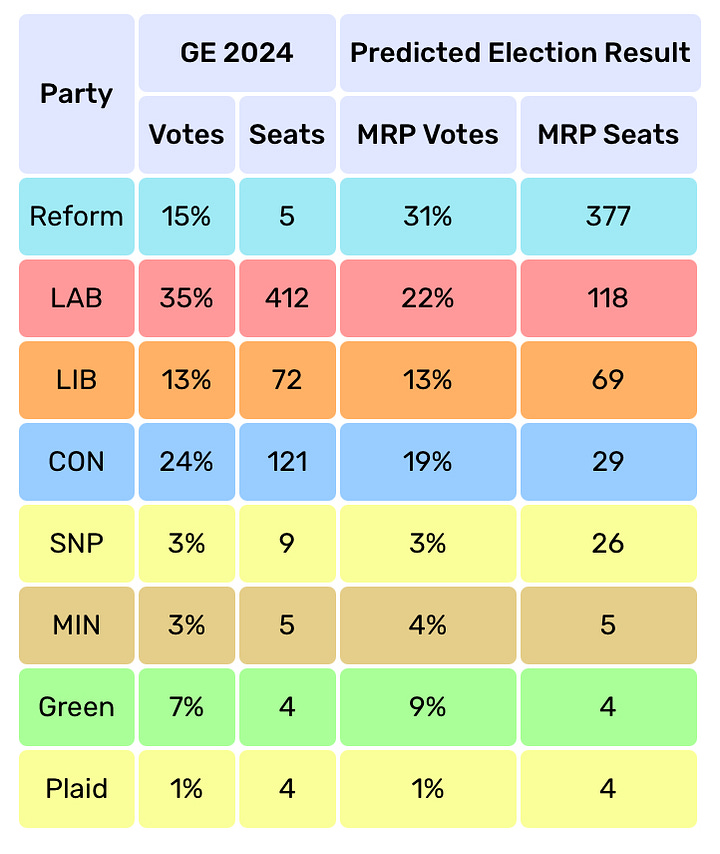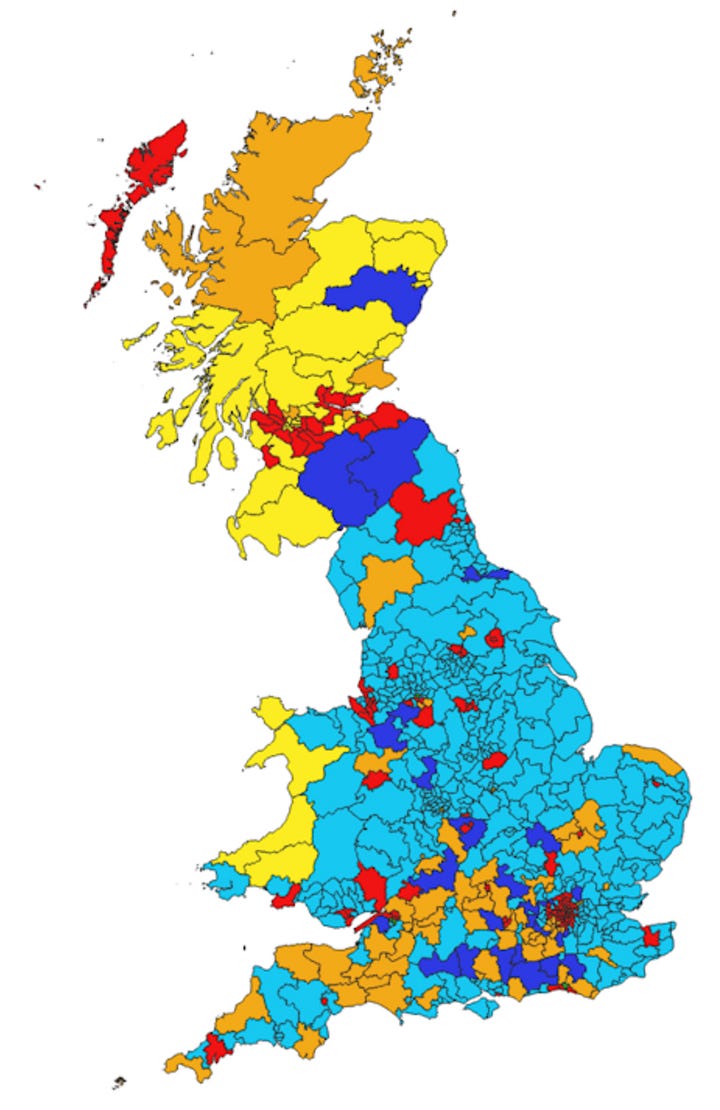Pollster: Find Out Now
Sample size: 5,444
Fieldwork dates: 10th - 17th June 2025
Source
Key points
The impacts of the Spending Review seem to be cutting Labour’s support.
Reform’s dominance across rural England is almost certain at this…
…yet this does not seem to be translating to seats in the South of England.
Another lead of 9% for Reform, just as Ipsos predicted, though with a more recent fieldwork. This means the more recent developments in politics and their impacts can be accounted for, including the Spending Review, but - perhaps most importantly - on the 14th June, the announcement by the government that there will be a nationwide inquiry into the grooming gang scandal. For many people, this will have indicated a serious u-turn on the part of the government, and perhaps even an admission of negligence in this crucial public issue.
This goes some of the way to explaining why Labour have fallen as low as 22%, while Reform continue to breach the 30% barrier.
Since this poll was taken in cooperation with Electoral Calculus, we have the benefit of EC looking at the seat-by-seat projections and converting this into an electoral map:


The Conservatives down to fourth party, and only barely there at 29, shortly ahead of the Scottish National Party, on 26. Meanwhile, Labour’s presence is reduced to just over a third of its current standing, and even the Liberal Democrats decline, by just three seats. With a solid lead over every other party, Reform emerges with a staggering 104 seat majority.
Given that this is an MRP (Multilevel Regression and Post-stratification) poll, and projected at the constituency level, there is a greater level of certainty (though parliamentary arithmetic does always distort votes and percentages. Even so, the confidence of a poll this large is higher than usual). At this stage, it is fairly safe to say that the SNP will resurge to their previous standing, holding as many as half of Scottish seats, while Reform is almost definitely going to be the largest party in Parliament. That sentence still feels odd to type, only a year on since Reform started outpacing other parties in the polls, but it’s increasingly hard to deny.
One of the reasons I enjoy reading the Find Out Now data is they break down the regions further than most pollsters. Here, for example, we can see a notable difference between the North East - where Reform are dominating the polls with 41%, and taking more than the Tories and Labour combined (16% and 19% respectively, 35% combined) - and Yorkshire and the Humber - where Labour are still performing fairly well, though they are still trailing behind Reform.
Moreover, the Conservatives are haemorrhaging support across rural England to Reform, in such a way that the threat of the Lib Dem’s taking swathes of seats from them in the South may actually have been forestalled. The map implies that the Tories will hold onto some of their strongholds in the South, and the Lib Dem’s will keep control of much of the South West - but Reform’s polling in this region (36%) is failing to convert into seats. This is, inevitably, Britain’s First Past the Post system at work, but it suggests that these seats may flip fully eventually.
Again, Find Out Now provides more complex break downs and crossbreaks than some other pollsters, and here the utility of that is shining through: for example, it is curious (though within the margin of error) that the Conservatives had 1% more support amongst under 25s than 25-34 year olds, while Reform has only 10% with the former and 20% with the later.
It’s still very low on all counts, especially with under-25s, and (as I’ve said before) indicates that the long-term electoral patterns of Britain’s political landscape is skewed towards left-leaning parties. It’s really something that the Green Party is the third-rank party amongst under-25s, as well as the Lib Dem’s performing better with younger voters - usually they take their support from The Middle (middle-aged, middle-classed).
But Reform’s dominance amongst older voters - the constituency most likely to turnout at elections, as the trend goes - is likely the source of their future electoral strength. The crossbreak is revealing here: in the sample, there are nearly twice as many over 65s as there are under 25s.
The best performing party with women is Reform, by a slim margin of 3% ahead of Labour’s 23%; the Conservatives are performing at parity between men and women, while Labour seems to have as much support amongst men as the Lib Dem’s do. This is an odd situation, but then I think if a year ago you’d said Reform was the best-performing amongst women, that would be odd too. Now it’s par for the course.
Thank you for reading this short Poll Watch post, in which I look at and discuss the most recent public opinion survey. Please consider subscribing to and sharing this blog and, if you’re feeling particularly generous, subscribing to my paid content -(detailed research and policy proposals).

